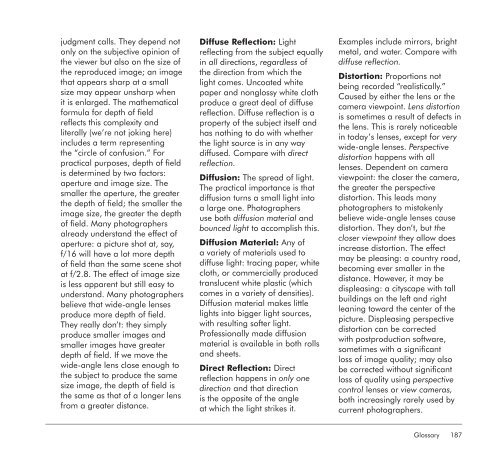Focus On Lighting Photos Focus on the Fundamentals.pdf
Create successful ePaper yourself
Turn your PDF publications into a flip-book with our unique Google optimized e-Paper software.
judgment calls. They depend not<br />
<strong>on</strong>ly <strong>on</strong> <strong>the</strong> subjective opini<strong>on</strong> of<br />
<strong>the</strong> viewer but also <strong>on</strong> <strong>the</strong> size of<br />
<strong>the</strong> reproduced image; an image<br />
that appears sharp at a small<br />
size may appear unsharp when<br />
it is enlarged. The ma<strong>the</strong>matical<br />
formula for depth of field<br />
reflects this complexity and<br />
literally (we’re not joking here)<br />
includes a term representing<br />
<strong>the</strong> “circle of c<strong>on</strong>fusi<strong>on</strong>.” For<br />
practical purposes, depth of field<br />
is determined by two factors:<br />
aperture and image size. The<br />
smaller <strong>the</strong> aperture, <strong>the</strong> greater<br />
<strong>the</strong> depth of field; <strong>the</strong> smaller <strong>the</strong><br />
image size, <strong>the</strong> greater <strong>the</strong> depth<br />
of field. Many photographers<br />
already understand <strong>the</strong> effect of<br />
aperture: a picture shot at, say,<br />
f/16 will have a lot more depth<br />
of field than <strong>the</strong> same scene shot<br />
at f/2.8. The effect of image size<br />
is less apparent but still easy to<br />
understand. Many photographers<br />
believe that wide-angle lenses<br />
produce more depth of field.<br />
They really d<strong>on</strong>’t: <strong>the</strong>y simply<br />
produce smaller images and<br />
smaller images have greater<br />
depth of field. If we move <strong>the</strong><br />
wide-angle lens close enough to<br />
<strong>the</strong> subject to produce <strong>the</strong> same<br />
size image, <strong>the</strong> depth of field is<br />
<strong>the</strong> same as that of a l<strong>on</strong>ger lens<br />
from a greater distance.<br />
Diffuse Reflecti<strong>on</strong>: Light<br />
reflecting from <strong>the</strong> subject equally<br />
in all directi<strong>on</strong>s, regardless of<br />
<strong>the</strong> directi<strong>on</strong> from which <strong>the</strong><br />
light comes. Uncoated white<br />
paper and n<strong>on</strong>glossy white cloth<br />
produce a great deal of diffuse<br />
reflecti<strong>on</strong>. Diffuse reflecti<strong>on</strong> is a<br />
property of <strong>the</strong> subject itself and<br />
has nothing to do with whe<strong>the</strong>r<br />
<strong>the</strong> light source is in any way<br />
diffused. Compare with direct<br />
reflecti<strong>on</strong>.<br />
Diffusi<strong>on</strong>: The spread of light.<br />
The practical importance is that<br />
diffusi<strong>on</strong> turns a small light into<br />
a large <strong>on</strong>e. Photographers<br />
use both diffusi<strong>on</strong> material and<br />
bounced light to accomplish this.<br />
Diffusi<strong>on</strong> Material: Any of<br />
a variety of materials used to<br />
diffuse light: tracing paper, white<br />
cloth, or commercially produced<br />
translucent white plastic (which<br />
comes in a variety of densities).<br />
Diffusi<strong>on</strong> material makes little<br />
lights into bigger light sources,<br />
with resulting softer light.<br />
Professi<strong>on</strong>ally made diffusi<strong>on</strong><br />
material is available in both rolls<br />
and sheets.<br />
Direct Reflecti<strong>on</strong>: Direct<br />
reflecti<strong>on</strong> happens in <strong>on</strong>ly <strong>on</strong>e<br />
directi<strong>on</strong> and that directi<strong>on</strong><br />
is <strong>the</strong> opposite of <strong>the</strong> angle<br />
at which <strong>the</strong> light strikes it.<br />
Examples include mirrors, bright<br />
metal, and water. Compare with<br />
diffuse reflecti<strong>on</strong>.<br />
Distorti<strong>on</strong>: Proporti<strong>on</strong>s not<br />
being recorded “realistically.”<br />
Caused by ei<strong>the</strong>r <strong>the</strong> lens or <strong>the</strong><br />
camera viewpoint. Lens distorti<strong>on</strong><br />
is sometimes a result of defects in<br />
<strong>the</strong> lens. This is rarely noticeable<br />
in today’s lenses, except for very<br />
wide-angle lenses. Perspective<br />
distorti<strong>on</strong> happens with all<br />
lenses. Dependent <strong>on</strong> camera<br />
viewpoint: <strong>the</strong> closer <strong>the</strong> camera,<br />
<strong>the</strong> greater <strong>the</strong> perspective<br />
distorti<strong>on</strong>. This leads many<br />
photographers to mistakenly<br />
believe wide-angle lenses cause<br />
distorti<strong>on</strong>. They d<strong>on</strong>’t, but <strong>the</strong><br />
closer viewpoint <strong>the</strong>y allow does<br />
increase distorti<strong>on</strong>. The effect<br />
may be pleasing: a country road,<br />
becoming ever smaller in <strong>the</strong><br />
distance. However, it may be<br />
displeasing: a cityscape with tall<br />
buildings <strong>on</strong> <strong>the</strong> left and right<br />
leaning toward <strong>the</strong> center of <strong>the</strong><br />
picture. Displeasing perspective<br />
distorti<strong>on</strong> can be corrected<br />
with postproducti<strong>on</strong> software,<br />
sometimes with a significant<br />
loss of image quality; may also<br />
be corrected without significant<br />
loss of quality using perspective<br />
c<strong>on</strong>trol lenses or view cameras,<br />
both increasingly rarely used by<br />
current photographers.<br />
Glossary 187



